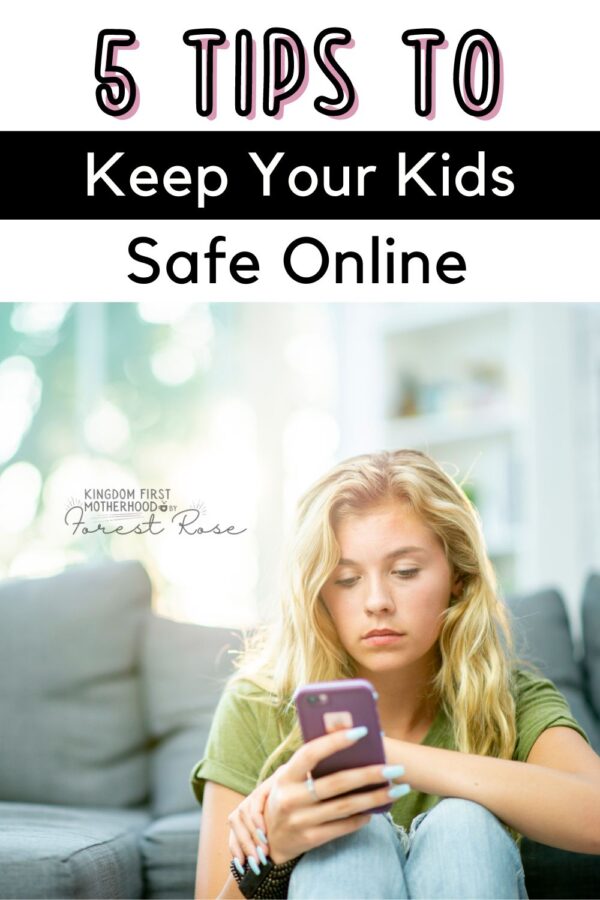The online world is like a giant playground for our kids, full of learning, fun, and chances to connect with friends. But just like a real playground, it has its share of risks. There have been several times when my daughter came to me, worried because a friend was being cyberbullied. Each time, it broke my heart, making me realize just how real these online threats can be. Online safety for kids is so important.

From cyberbullying to stumbling upon inappropriate content to understanding the slang our kids use, like PMOYS- Do you know what the PMOYS meaning is? Seriously though our kids can face tons of dangers online. As parents, we have to be their digital bodyguards. Staying informed about what they’re doing online and keeping the lines of communication open can really help keep them safe. Let’s be proactive in understanding and guiding them through this vast digital landscape.
Contents
Educate Your Kids About Online Safety
One of the crucial steps in safeguarding your children’s online experience is educating them about the multiple dangers they may encounter. It’s not just about setting rules and restrictions, it’s about having open and honest conversations that help them understand the risks and make informed decisions. This involves discussing those dangers associated with several key areas:
First, talk to them about cyberbullying. Explain how it can happen and what to do if they or someone they know becomes a target. Share stories or examples they can relate to, making it clear that they should always come to you if they feel threatened or uncomfortable online.
Next, cover the topic of inappropriate content. Kids need to know that not everything on the internet is suitable for them. Teach them how to recognize and avoid harmful content, and let them know they can always ask for help if they come across something disturbing.
Another important area is privacy and personal information. Help them understand why it’s essential to keep personal details, like their full name, address, and school name, private. Discuss the importance of strong passwords and being cautious about what they share on social media.
Online predators are another serious concern. Explain that not everyone online is who they say they are. Encourage them to be cautious about talking to strangers and to report any suspicious behavior immediately.
Lastly, talk about digital footprints. Make sure they understand that what they post online can stay there forever and can affect their future. Encourage them to think before they post and to consider the long-term impact of their online actions.
By having these discussions, you empower your children to navigate the online world more safely and confidently. It’s all about giving them the tools and knowledge they need to protect themselves and make smart choices.
By being aware of these risks, your children will be better equipped to navigate safely while online.
It’s important to set clear rules and boundaries for how your child uses the internet. This not only keeps them safe but also helps them develop healthy habits and a balanced lifestyle.
5 Tips to Keep Your Children Safe on the Internet
1- Guidelines for Internet Use
Start by determining which websites and apps are suitable for your child and which ones they should avoid. This might involve creating a list of approved sites and setting up parental controls to block inappropriate content. It’s also helpful to explain why certain sites are off-limits, so they understand the reasoning behind your decisions.
2- Time Restrictions
Establish specific times and durations for your child’s online activities each day. For example, you might allow screen time after homework is completed or set a daily limit of one or two hours. Consistency is key, so make sure these rules are followed regularly. Encourage your child to take breaks to avoid prolonged periods of screen time, which can lead to eye strain and other health issues.
3- Device-Free Areas
Identify areas in your home where devices are not allowed, such as the dining room or bedrooms. This encourages face-to-face interactions and family bonding during meals and ensures a restful environment for sleep. Creating device-free zones helps children learn to disconnect and engage in offline activities, promoting a healthier balance between online and offline life.
4- Monitoring and Supervision
Keep an eye on your child’s online activities by periodically checking their browsing history and the apps they use. This doesn’t mean invading their privacy but ensuring they are staying within the boundaries you’ve set. Encourage them to come to you if they encounter anything uncomfortable or confusing online.
5- Open Communication
Maintain an open dialogue about their online experiences. Ask them about the games they play, the videos they watch, and the friends they interact with online. Being genuinely interested in their digital world fosters trust and makes them more likely to approach you with any concerns.
Having these guidelines in place helps children learn the value of balancing their time between online and offline activities. It’s all about creating a safe, structured environment where they can enjoy the benefits of the internet while also developing other important life skills.
Here are some additional tips for managing your child’s online activities:
- Set a Good Example: Model healthy internet habits yourself. Children are more likely to follow your rules if they see you practicing what you preach.
- Involve Them in Rule-Making: Get your child involved in setting the rules. This can make them feel more responsible and invested in following the guidelines.
- Encourage Other Interests: Promote offline hobbies and activities like reading, sports, or arts and crafts. This helps diversify their interests and reduces their reliance on digital entertainment.
- Be Consistent: Consistency is key to enforcing these rules. Make sure everyone in the household understands and follows the guidelines to avoid confusion and ensure fairness.
By taking these steps, you can create a balanced and safe online environment for your child, helping them make the most of their digital experiences while still enjoying the richness of the offline world.
Establishing trust through open and honest dialogue encourages your child to seek help whenever they need it. As a mom, I know how important it is to keep those lines of communication wide open.
So, in a nutshell, keeping our kids safe online is all about a mix of education, setting clear boundaries, using the right tools, and keeping an eye on what they’re up to. But most importantly, it’s about talking to them and making sure they know they can always come to us with any worries or questions.
By doing all this, we can help our kids enjoy the internet while keeping them safe from the not-so-nice parts. Think of it like giving them a sturdy umbrella in a rainstorm—equipping them to navigate the online world with confidence and safety. Stay vigilant, stay informed, and always be ready to support your child’s well-being. We’re their first line of defense and their biggest cheerleaders. Together, we can create a safe and balanced digital environment where they can learn, explore, and thrive.
FAQ
1. What are the risks children face on the internet?
Kids can face several risks online, including cyberbullying, exposure to inappropriate content, interacting with strangers, and falling for phishing scams. It’s a big, wide world out there, and not all of it is friendly.
2. How can I have a conversation with my children about staying safe online?
Talking to your kids about online safety can feel tricky, but it’s essential. Use age-appropriate language and be honest about the dangers. Encourage them to ask questions and create a safe space where they feel comfortable discussing these topics. The goal is to keep the conversation open and ongoing.
3. Do parental control tools work well?
Parental control tools can be very effective in filtering content, monitoring usage, and setting time limits. However, they work best when combined with other safety measures, like open communication and educating your kids about online risks.
4. What should I do if my child comes across something inappropriate online?
Stay calm and talk to your child about what they’ve seen. It’s important to reassure them and take appropriate action, such as reporting the content or blocking the source. Your calm response will help them feel safe and supported.
5. How can I stay updated on trends in online safety?
Keeping up with the latest in online safety is crucial. Follow reputable websites, subscribe to newsletters, and join parent forums where you can share experiences and seek advice. Staying informed will help you better protect your child in the ever-changing digital landscape.

For more homeschooling inspiration, tips and encouragement, make sure to follow KFH on Facebook, Pinterest, Instagram and Twitter, and subscribe to our Newsletter for some FREE GOODIES!
Forest Rose is a God Loving, Blessed Wife, & Mama to 3 girls. She’s passionate about lifting moms out of the trenches that are discouraged, overwhelmed, or feeling alone or isolated. Her hope is to point them to Christ and equip them to rise up with a newfound hope and joy within, that He alone can provide. Besides blogging, she also loves to create printables!




Leave a Reply